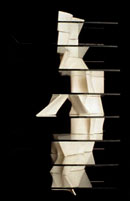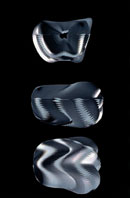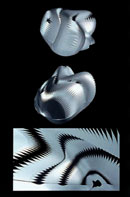
Animation
is a term that differs from, but is often confused with, motion. While
motion implies movement and action, animation implies the evolution
of a form and its shaping forces; it suggests animalism, animism, growth,
actuation, vitality and virtuality. In its manifold implications, animation
touches on many of architecture's most deeply embedded assumptions about
its structure. What makes animation so problematic for architects is
that they have maintained an ethics of statics in their discipline.
More than even its traditional role of providing shelter, architects
are expected to provide culture with stasis. Because of its dedication
to permanence, architecture is one of the last modes of thought based
on the inert.
Challenging
these assumptions by introducting architecture to models of organization
that are not inert will not threaten the essence of the discipline,
but will advance it. Just as the development of calculus drew upon the
historical mathematical developments that preceded it, so too will an
animate approach to architecture subsume traditional models of statics
into a more advanced system of dynamic organizations as a subset. The
uses for an animate approach to architecture might be in its conception
and design while more conventional tools remain in force for modeling
and fabrication. Traditionally, in architecture the abstract space of
design is conceived as an ideal neutral space of equivalent Cartesian
coordinates. In other design fields, however, design space is conceived
as an environment of forces rather than as an inert neutral vacuum.
In naval design, for example, the abstract space of design is imbued
with the properties of flow, turbulence, viscosity, and drag so that
the particular form of a hull can be thought of in terms of its motion
through water. Although the form of a boat hull is studied in motion
within an abstract space that has properties, there is no expectation
that the shape of the boat hull will literally move. Similarly, an ethics
of motion neither implies that architecture must be literally moveable,
nor does it preclude actual motion. The contours and profiles of form
can be shaped by the collaboration between an envelope and the active
context in which it is situated. While physical form can be defined
in terms of static coordinates, the virtual force of the environment
in which it is designed should also contribute to its shaping. (...)
In this way, topology allows for not just the incorporation of a single
moment but rather a multiplicity of vectors, and therefore, a multiplicity
of times, in a single continuous surface.(...)
The
availability and rapid colonization of architectural design by computer-aided
techniques presents the discipline with yet another opportunity to both
retool and rethink itself as it did with the advent of stereometric
projection and perspective. If there is a single concept that must be
engaged due to the proliferation of topological shapes and computer-aided
tools, it is that in their structure as abstract machines, these technologies
are animate.



